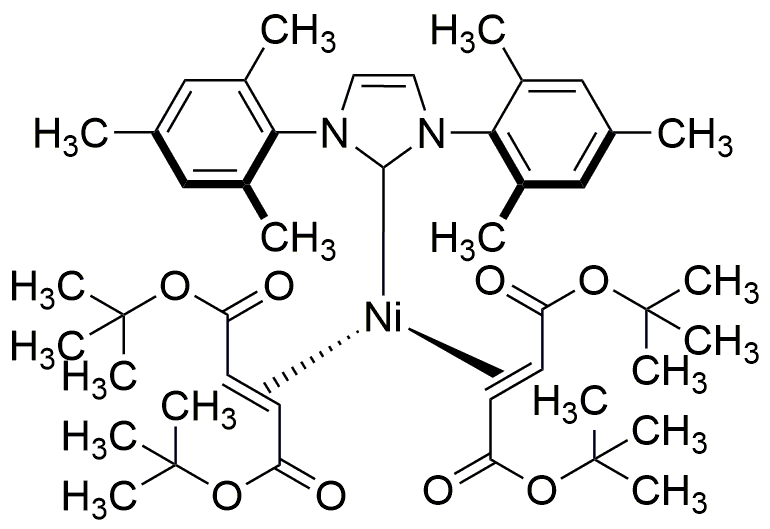(1,3-Dimesitylimidazol-2-ylidene)nickel(0) bis(di-tert-butyl fumarate) is widely utilized in research focused on:
- Catalysis: This compound serves as an effective catalyst in various organic reactions, enhancing reaction rates and selectivity, particularly in cross-coupling reactions. Researchers in the field of organic synthesis benefit from its efficiency compared to traditional catalysts.
- Material Science: It is used in the development of advanced materials, including polymers and nanomaterials, where its unique properties can improve material performance and stability.
- Green Chemistry: The compound contributes to sustainable practices by facilitating reactions that minimize waste and reduce the use of hazardous solvents, appealing to industries focused on environmentally friendly processes.
- Pharmaceutical Development: In drug synthesis, it aids in the formation of complex molecules, streamlining the production of pharmaceuticals, which is crucial for researchers aiming for efficiency in drug discovery.
- Electrochemistry: This chemical plays a role in the development of electrochemical devices, such as batteries and fuel cells, where it can enhance performance and energy efficiency, making it valuable for energy research sectors.
General Information
Properties
Safety and Regulations
Applications
(1,3-Dimesitylimidazol-2-ylidene)nickel(0) bis(di-tert-butyl fumarate) is widely utilized in research focused on:
- Catalysis: This compound serves as an effective catalyst in various organic reactions, enhancing reaction rates and selectivity, particularly in cross-coupling reactions. Researchers in the field of organic synthesis benefit from its efficiency compared to traditional catalysts.
- Material Science: It is used in the development of advanced materials, including polymers and nanomaterials, where its unique properties can improve material performance and stability.
- Green Chemistry: The compound contributes to sustainable practices by facilitating reactions that minimize waste and reduce the use of hazardous solvents, appealing to industries focused on environmentally friendly processes.
- Pharmaceutical Development: In drug synthesis, it aids in the formation of complex molecules, streamlining the production of pharmaceuticals, which is crucial for researchers aiming for efficiency in drug discovery.
- Electrochemistry: This chemical plays a role in the development of electrochemical devices, such as batteries and fuel cells, where it can enhance performance and energy efficiency, making it valuable for energy research sectors.
Documents
Safety Data Sheets (SDS)
The SDS provides comprehensive safety information on handling, storage, and disposal of the product.
Product Specification (PS)
The PS provides a comprehensive breakdown of the product’s properties, including chemical composition, physical state, purity, and storage requirements. It also details acceptable quality ranges and the product's intended applications.
Certificates of Analysis (COA)
Search for Certificates of Analysis (COA) by entering the products Lot Number. Lot and Batch Numbers can be found on a product’s label following the words ‘Lot’ or ‘Batch’.
*Catalog Number
*Lot Number
Certificates Of Origin (COO)
This COO confirms the country where the product was manufactured, and also details the materials and components used in it and whether it is derived from natural, synthetic, or other specific sources. This certificate may be required for customs, trade, and regulatory compliance.
*Catalog Number
*Lot Number
Safety Data Sheets (SDS)
The SDS provides comprehensive safety information on handling, storage, and disposal of the product.
DownloadProduct Specification (PS)
The PS provides a comprehensive breakdown of the product’s properties, including chemical composition, physical state, purity, and storage requirements. It also details acceptable quality ranges and the product's intended applications.
DownloadCertificates of Analysis (COA)
Search for Certificates of Analysis (COA) by entering the products Lot Number. Lot and Batch Numbers can be found on a product’s label following the words ‘Lot’ or ‘Batch’.
*Catalog Number
*Lot Number
Certificates Of Origin (COO)
This COO confirms the country where the product was manufactured, and also details the materials and components used in it and whether it is derived from natural, synthetic, or other specific sources. This certificate may be required for customs, trade, and regulatory compliance.


